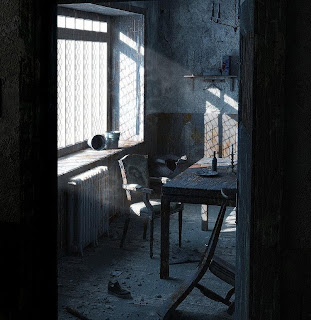Abandoned Places. Any-Space-Whatevers. Cinema.

A while back I noticed I have a fascination for long abandoned buildings. And thinking about it not just buildings, but also long abandoned cars, trucks and graveyards (these are what spring to mind right now, there may be more).
Old industrial sites often do it for me the most. Sites that were previously almost completely functional rather than dwellings, although old dwellings have a similar if weaker effect. It was a bit of a mystery why this was, and at first I thought it might just be a sort of maudlin interest in death and decay, the sort of thing kids sometimes feel when they visit tombs and imagine the rotting cadavers inside or dusty skeletons. And even today there is a sort of imaginative re-creation like that going on when I wander through one of these places, or see an old car and wonder about the miles it's done and the stories from peoples' lives it knows. Walking through an old industrial site, it's often the more mundane areas like washrooms and offices which have the strongest effect, any place where people used to congregate and do everyday work things.
The fascination has become clearer to me over time, via the unexpected detour of film theory. I've mentioned Deleuze's wonderful Cinema 1 and Cinema 2 here indirectly before, his two-volume exploration of film as an image system, where image has a very particular meaning. Traditionally image has a representational sense for people, we think of 'looking at' images. Deleuze approaches this completely differently, using an idea about images Bergson elaborated back in the late 1890s, in his extraordinary Matter and Memory (go and read that one, by the way, if more people had in the 19th century we wouldn't have many of the infantile ideas in psychology and neuroscience that are considered cutting edge today, due partly to the sidelining of philosophy in the academy). Cinema 1 gives a summary of this different approach:
In short, cinema does not give us an image to which movement is added, it immediately gives us a movement-image. It does give us a section, but a section which is mobile, not an immobile section + abstract movement.
In other words, when you watch a film you don't string together 24 static snapshots/frames per second and then add the movement to them. You perceive it as a moving image. And at the same time you don't really look 'at' films, just as you don't look'at' photos. Or at least you don't when you're truly engaged with them, as the average photo and film viewer is. They don't say "oh look, there's a photo of Aunty Emma and her dog", they say "there's Aunty Emma and her dog". Or they sit and cry or laugh or jump in a film, they don't say "oh, this film is making me sad, maybe I should cry now." The representational idea about looking at things is an idealised abstraction from actual experience.
Anyway, to get back to what this has to do with abandoned things. Over the course of its development film has shifted from an emphasis upon movement-images to an emphasis upon what Deleueze calls time-images. Along this progression are intermediate stages (although there is no necessary hieracrhy here) such as the action-image, affection-image and mental-image. For example the close-up is a classic affection-image, because it's invariably used not to just show a face (i.e. not a simple movement-image or action-image), but to show an affect or feeling, such as fear. You could easily multiply examples of this from your own viewing, the actor's face in close-up expressing horror or whatever in what they're observing, which is out of shot. You feel the horror and the tension, but you're not actually seeing the physical cause of that feeling. Similarly Hitchcock was one of the pioneers of the mental-image in cinema, where as a viewer what you're observing creates a "what's happening here?" (for example) 'mental' experience in you, such as when Hitchocok shows two people going up some stairs, through a door, and then pans back out through the entry to the building, with a suddenly emerging realisation (mental process) in you that the woman is being murdered behind that door.
As these various types of images developed in cinema, the 'spaces' that were being filmed changed at the same time. In the standard movement-image the movement appears to take place in the standard way, like a film of somebody riding a bike down a street. But once you start to see affection-images, mental-images and time-images, the space of the action becomes what Deleuze calls any-space-whatever. This also corresponded in some way with the development of the 'film set', where increasingly the location was fabricated and played with, sometimes almost to the point of cartoon-like irreality. Musicals were a stage in this progression, with Gene Kelly taking what looks like an ordinary city street and turning it into a set of props in a dance. At the same time outside film Europe in particular was littered with such spaces - deserted and bombed cities and factories, spaces where people had once lived and worked which were now abandoned. Space emptied of it's traditional roles becomes any-space-whatever.
This is where the a-ha hit me, as I realised that the abandoned places I love are any-space-whatevers. More on why and what that actually means next time.


You might have already seen these, but if you want desolate spaces of the bleakest kind, go to http://www.sweet-juniper.com/2007/11/it-will-rise-from-ashes.html and then follow the flickr link!
ReplyDeleteNo, I hadn't - extraordinary. Thanks so much.
ReplyDeleteWhile we're on a roll, presume you've done Gunkanjima - here's a couple of links, http://www.fingel.com/tag/gunkanjima/
ReplyDeleteand http://architecturelab.net/2008/06/01/gunkanjima-island/
My own personal favorites are Salton Sea in California http://en.wikipedia.org/wiki/Salton_Sea and Bodie, California, http://en.wikipedia.org/wiki/Bodie,_California but perhaps that's because I've seen them. Just love those desolate places.
Maybe that's why I like The Wire.
cheers